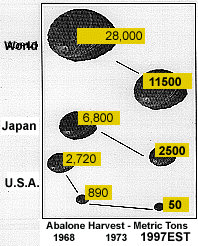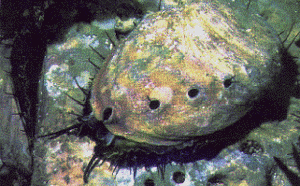A worldwide source for
marine aquaculture, focusing on world abalone
farming.
Current abalone
projects in:
- U.S.A.
- China
- Ireland
- Israel
- Chile
- Uruguay
- Argentina
- Canada
- Peru
- Greece

In the animal kingdom, abalone belong to the phylum Mollusca, a group which includes clams, scallops, sea slugs, octopuses, and squid, Molluscs are world wide and predominantly marine. They have a soft body surrounded by a mantle, and anterior head, and a large muscular foot. Molluscs are best known for their beautifully formed and colored calcareous shell secreted by the mantle.
The abalone join other snails, whelks, and sea slugs in the class Gastropoda. Members of this class have one shell, as opposed to clams with two, (or the shell may be lacking altogether, as in the sea slugs). The spiral structure, so common in snail shells, is flattened in the abalone and may be obscured by fouling and shell boring organisms. Abalone are members of the family Haliotidae and the genus haliotis, which means sea ear, referring to the flattened shape of the shell. The name abalone is probably derived from the Spanish-American word aulon or aulone.
Anatomy
The most conspicuous part of any abalone is the shell, with its row of respiratory pores. Shells are prized because of their inner, iridescent layer. The muscular foot has a strong suction power permitting the abalone to clamp tightly to rocky surfaces. A column of shell muscle attaches the body to its shell. The mantle circles the foot as does the epipodium, a sensory structure and extension of the foot which bears tentacles. The epipodium projects beyond the shell edge in the living animal. The epipodium surface may be smooth or pebbly in appearance and its edge may be frilly or scalloped. It is the most reliable structure for identifying abalone species.
The internal organs are arranged around the foot and under the shell. The most conspicuous organ, the crescent-shaped gonad, is gray or green in females and cream colored in males. It extends around the side opposite the pores and to the rear of the abalone. The abalone has had a pair of eyes, a mouth and an enlarged pair of tentacles. Inside the mouth is a long, file-like tongue called the radula, which scrapes algal matter to a size that can be ingested.
The gill chamber is next to the mouth and under the respitory pores. Water is drawn in under the edge of the shell, and then flows over the gills and out the pores. Waste and reproductive products are carried out in the flow of water. Since it has no obvious brain structure, the abalone is considered to be a primitive animal. However, it does have a heart on its left side and blood flows through he arteries, sinuses and veins, assisted by the surrounding tissues and muscles.
FISHTECH works with the following species:
- Haliotis rufescens
- Haliotis fulgens
- Haliotis discus
- Haliotis discus hannai
- Haliotis diversicolor supertesta
- Haliotis iris
- Haliotis Tuberculata
- Haliotis Kamtschatkana

FISHTECH works with 9 different species of abalone worldwide. Click on the link to read some information about Red Abalone.
Reproduction
The sexes are separate and can be distinguished in individuals as small as one inch when the gonads begin to develop. The eggs or sperm are releases through the pores with the respiratory current. This is known as broadcast spawning. A 1.5 inch abalone may spawn 10,000 eggs or more at a time, while and 8 inch abalone may spawn 11 million or more. Spawning may be controlled by the water temperature or length of the day. The presence of eggs and sperm in the water may stimulate other abalone to spawn, thus increasing the chances of fertilization. The egg hatches as a microscopic, free living larvae. It drifts with the currents for about a week, then the abalone larvae settles to the bottom, sheds its swimming hairs (cilia) and begins to develop the adult shell form.If suitable habitat is located it may grow to adulthood. the chance that an individual larva will survive to adulthood is very low. fortunately abalone and most molluscs are prolific spawners but the mortality still probably exceeds 99%. Hybrid abalone are not uncommon in areas where several species occur together. All species can hybridize, but he most common hybrids are red and white with pink.
Food
Abalone eat marine algae. The adults feed on loose pieces of algae drifting with the surge of the current. Large brown algae such as giant kelp, bull kelp, feather boa kelp and elk kelp are preferred, although most others may be eaten at various times. Abalone tend to stay in one location waiting for food to drift by. However, they will move daily, seasonally or when food becomes scarce for a long period. The color banding on many abalone shells is due to changes in the types of algae eaten. Juvenile abalone graze on rock encrusting coralline algae and on diatoms and bacterial films. As they grow they increasingly rely on drift algae.
Age and Growth

Determining the age of an individual abalone is difficult. Unlike the hard parts of some animals, abalone shells have no marks or bands suitable for assigning age. However, juvenile abalone in aquariums grow and inch or more per year for the first two years. Tagging studies have provided estimates of age for larger abalone in the wild. Red abalone are mature at 1.5 to 2.0 inches when growth begins to slow with age. For instance, a seven inch red abalone may be 7-10 years old, while one only 3/4 of an inch longer may be 15 years or older.
HOME | General Information | Services | Why Farm Abalone Training Services | Abalone Recipes | Email & Survey
.
1750 Montgomery St.
San Francisco, CA 94111
FAX International: 1-415-474-0529
FAX within USA: 1-800 628 9678